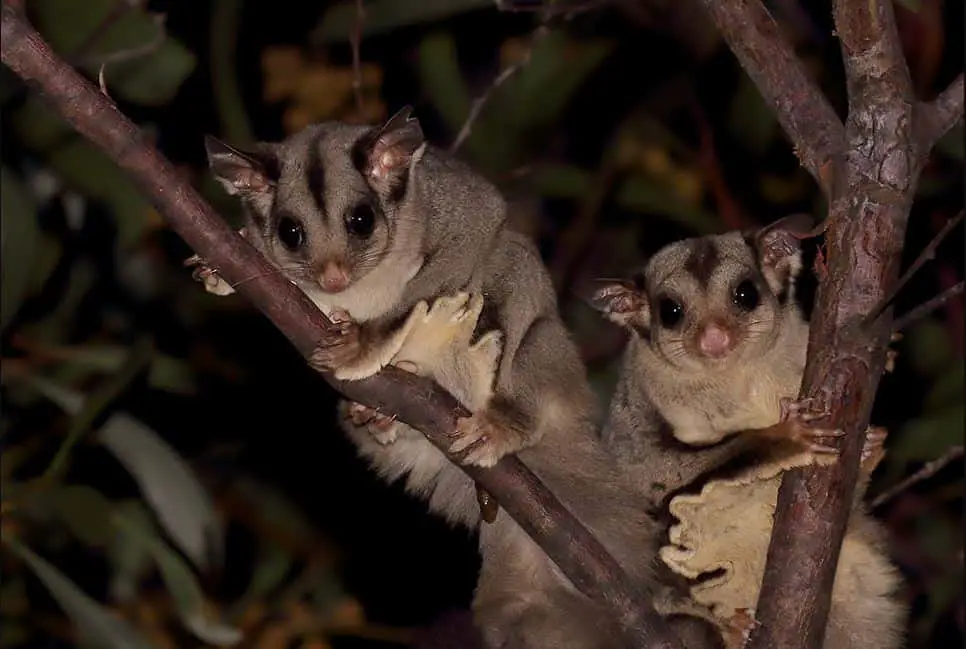Sugar gliders are some of the most adorable animals in the world. These tiny marsupials have gotten quite popular as pets. However, there are quite a few things that people do not know about them. To properly care for them you need to know certain things about them. For instance, you have to know when they’re awake and when they’re asleep. In other words, you need to know the answer to the question: are sugar gliders nocturnal?
Today, we’re going to cover everything you need to know about this topic, so let’s jump right in.
Are sugar gliders nocturnal?

Yes, sugar gliders are nocturnal. Being nocturnal means that they’re awake at night and asleep during the day. Sugar gliders typically wake up a few hours after dusk and stay up until dawn, after which they sleep the rest of the day. In total, they’re awake for about 12 hours and they sleep for the remaining 12 hours.
The reason why sugar gliders are nocturnal is that the darkness of the night allows them to hide from predators. Snakes, feral cats, kookaburras, lizards, and birds all prey on the tiny sugar glider in the wild. In order to protect themselves, they forage for food at night rather than during the day because they’re much harder to spot at night.
For pet owners, this might be something that you’ll have to adapt to. Humans are not nocturnal, they’re awake during the day and sleep at night. As a result, you might be asleep when your glider is awake and vice versa. In addition, sugar gliders can make quite a lot of noise. For instance, they can bark and make other sounds that can keep you up at night. For that reason, you have to make absolutely sure that you can properly care for one of these animals before getting one. They are exotic animals and will never truly be domesticated like a dog or a cat.
Can you change your sugar glider’s sleep schedule?
No, you cannot change your pet sugar glider‘s natural sleep schedule. Millions of years of evolution have caused them to be nocturnal. Just because them being awake at night and asleep during the day might be inconvenient for you will not change that.
Some owners try to trick their sugar gliders into believing that it’s the night when it’s actually the middle of the day and the other way around. They do this by darkening their cage during the day and keeping a light on at night. This often does not work very well because you have to be extremely consistent with it. If you mess up a few times it will just confuse and stress out your sugar glider.
Therefore, changing your glider’s sleep schedule to fit yours is not a good idea. Respect the differences between your and your glider and accept that the animal that you have adopted has its own nature.
How seasons affect their sleep schedule

In the Northern hemisphere the days are shorter in the winter and longer in the summer. These seasonal changes might affect your sugar glider’s sleep schedule.
Gliders wake up when it gets dark outside and go to sleep when it’s light outside. Since it gets dark earlier in the winter they might wake up earlier in the winter. On the other hand, in the summer, it gets dark later. As a result, gliders often wake up later in the summer.
Can sugar gliders see in the dark?
Sugar gliders are known for their big, round eyes. These eyes have evolved specifically to work well in low-light environments because they have many rods. Rods are cells that are stimulated by light over a wide range of intensities and are responsible for perceiving the size, shape, and brightness of visual images.
However, the trade-off that gliders make is that they have quite a poor color vision. They’re not quite color blind, but they do not see the wide range of colors that we do. It’s believed that sugar gliders see in shades of gray and the color red.
The reason why they made the trade-off to prioritize low-light vision is simple, they’re active at night so they do not benefit a whole lot from seeing colors. They benefit a lot more from being able to see anything at all in low-light environments.
Another interesting thing about the eyes of gliders is that they’re located on the side of their head. The reason for this is that they’re prey animals. They have a lot of predators that try to sneak up on them and eat them. Having their eyes on the side of their head rather than on the front gives them a very wide field of view and gives them a chance to notice predators sneaking up on them before it’s too late.
Do sugar gliders need a light at night?
Some sugar glider owners wonder if they should provide their furry friends with some light at night so that they can get around their enclosure while their owner is asleep.
Luckily, this is not necessary. Gliders are perfectly capable of finding their way around without needing any artificial light. In fact, giving them a nightlight might do more harm than good because it might confuse the circadian rhythm. Nightlights might confuse your glider into thinking it’s the middle of the day when it’s actually night which can prevent their sleep/wake cycle from functioning properly.
Final words
Sugar gliders are nocturnal animals. They typically wake up around 10 PM and then stay awake until the sun comes up. They can be quite noisy at night as they go about their business. This is definitely something that you need to be prepared to deal with if you decide to adopt them as a pet.
Changing your sugar glider’s sleep schedule is possible but not recommended. It’s best to accept that they’re nocturnal creatures and to learn to live with their nightly antics. If you cannot, it’s best to get a different pet that is not nocturnal, such as a guinea pig.
- How Long Do American Eskimo Dogs Live? Important Factors and Care Tips - September 29, 2023
- Do American Bulldogs Need Grooming? Essential Tips and Care Guidelines - September 29, 2023
- Do Bengal Cats Enjoy Playing? Essential Tips for Keeping Them Active - September 29, 2023